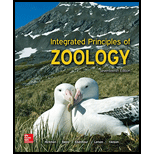
Explain each of these properties of water, and describe how each is conferred by the dipolar nature of a water molecule: high specific heat capacity; high heat of vaporization; unique density behavior; high surface tension; capacity to be a good solvent for ions of salts.
To explain: The properties of water including high specific heat capacity, the high heat of vaporization, high surface tension, a good solvent for ions and unique density and also how these properties are conferred by the dipolar nature of a molecule of water.
Introduction: Water is very important for maintaining life on earth. It is the most abundant compound. It forms 70% of a living individual.
Explanation of Solution
Water consists of several unique properties. These properties play an essential role in the living world. Hydrogen bonds are present between two adjacent molecules of water that underlie all these properties.
- High specific heat capacity- To increase the temperature of 1 g of water to 1°C, 1 calorie is needed. Water has the highest thermal capacity than other liquid. This energy is used for breaking hydrogen bonds and increases kinetic energy.
- High heat of vaporization- To convert 1g of water to vapor, it requires more than 500 calories. Hence, water has a high heat of vaporization.
- Unique density behavior- Water has a unique density behavior when there is a change in temperature. Most of the liquid forms become denser when the temperature decreases. However, water is the only one who reaches its maximum point of density, that is, at 4°C and can still remain a liquid.
- High surface tension- Water has exceeding surface tension than any liquid except mercury. Cohesiveness produces by hydrogen bonding is important for regulating protoplasmic form, which results in creating an ecological niche for insects.
- Good solvent- Water is a very good solvent. The dipolar nature of water created this property. It causes water molecules to revolve around charged ions.
Solvents that lack dipolar nature are less effective in keeping the ions separated.
Want to see more full solutions like this?
Chapter 2 Solutions
LooseLeaf for Integrated Principles of Zoology
- 22. Which of the following mutant proteins is expected to have a dominant negative effect when over- expressed in normal cells? a. mutant PI3-kinase that lacks the SH2 domain but retains the kinase function b. mutant Grb2 protein that cannot bind to RTK c. mutant RTK that lacks the extracellular domain d. mutant PDK that has the PH domain but lost the kinase function e. all of the abovearrow_forwardWhat is the label ?arrow_forwardCan you described the image? Can you explain the question as well their answer and how to get to an answer to an problem like this?arrow_forward
- Describe the principle of homeostasis.arrow_forwardExplain how the hormones of the glands listed below travel around the body to target organs and tissues : Pituitary gland Hypothalamus Thyroid Parathyroid Adrenal Pineal Pancreas(islets of langerhans) Gonads (testes and ovaries) Placentaarrow_forwardWhat are the functions of the hormones produced in the glands listed below: Pituitary gland Hypothalamus Thyroid Parathyroid Adrenal Pineal Pancreas(islets of langerhans) Gonads (testes and ovaries) Placentaarrow_forward
 Human Biology (MindTap Course List)BiologyISBN:9781305112100Author:Cecie Starr, Beverly McMillanPublisher:Cengage Learning
Human Biology (MindTap Course List)BiologyISBN:9781305112100Author:Cecie Starr, Beverly McMillanPublisher:Cengage Learning Concepts of BiologyBiologyISBN:9781938168116Author:Samantha Fowler, Rebecca Roush, James WisePublisher:OpenStax College
Concepts of BiologyBiologyISBN:9781938168116Author:Samantha Fowler, Rebecca Roush, James WisePublisher:OpenStax College
 Biology (MindTap Course List)BiologyISBN:9781337392938Author:Eldra Solomon, Charles Martin, Diana W. Martin, Linda R. BergPublisher:Cengage Learning
Biology (MindTap Course List)BiologyISBN:9781337392938Author:Eldra Solomon, Charles Martin, Diana W. Martin, Linda R. BergPublisher:Cengage Learning Biology Today and Tomorrow without Physiology (Mi...BiologyISBN:9781305117396Author:Cecie Starr, Christine Evers, Lisa StarrPublisher:Cengage Learning
Biology Today and Tomorrow without Physiology (Mi...BiologyISBN:9781305117396Author:Cecie Starr, Christine Evers, Lisa StarrPublisher:Cengage Learning





